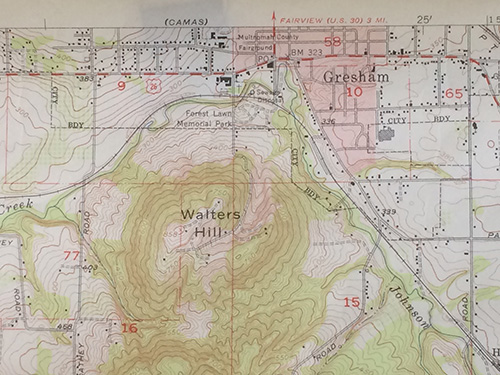
1969
Main St. continued from Powell Blvd. as it does today except there were train tracks where the Springwater trail is today. There was a waste water facility where the lower baseball field sets today. Johnson Creek traveled north to Powell Blvd. and made a major turn south at Powell Blvd. along Main St. to the Main St. bridge and went under the bridge and continued as it does today, at least in the Gresham area. From the northeast another creek called Thompson Creek flowed into Johnson Creek. The area where Main City Park is now, was a wrecking yard called Welty and Son Wrecking Company. His family, who owned one of the two wrecking yards located in Gresham. Today’s barn area, storage yard and two homes were part of the family-owned business property.
If a person visualizes Johnson Creek following the east property line to the north of the park and turning back, we would realize that all of the area between the creeks route was a storage yard for wrecked cars. Since Johnson Creek followed the path south, close to today’s “Spur Trail”, there had to be another way to get over the creek to the homes and the car storage area, and there was. Near the area of the garden bridge was a heavy duty vehicle bridge that was built in a west/east arrangement and went over Johnson Creek while the Main St. bridge allowed access to the dismantle area where the barn is. There were also other structures on the west side of the park and on the south side of Powell Blvd. between Main St. and Roberts.
A $900,000 bond was voted on by the City of Gresham citizens and passed that would allow construction in several areas.
- Powell Blvd. between Main Street and Burnside would be widened.
- Structures between Main and Roberts would be purchased and removed.
- The Welty land would be purchased.
- Johnson Creek would be re-routed from east to west to the Main City bridge to eliminate flooding up to Powell.
- The old route of Johnson Creek would be filled with materials from the new Johnson Creek Trunk Sewer project.
With construction beginning in the last quarter of 1969, through the winter of 1970 plans were being laid out for Main City Park and the Island. This is when the Japanese American Citizens League began the effort to design and construct a Japanese garden on what is known today as Tsuru Island.
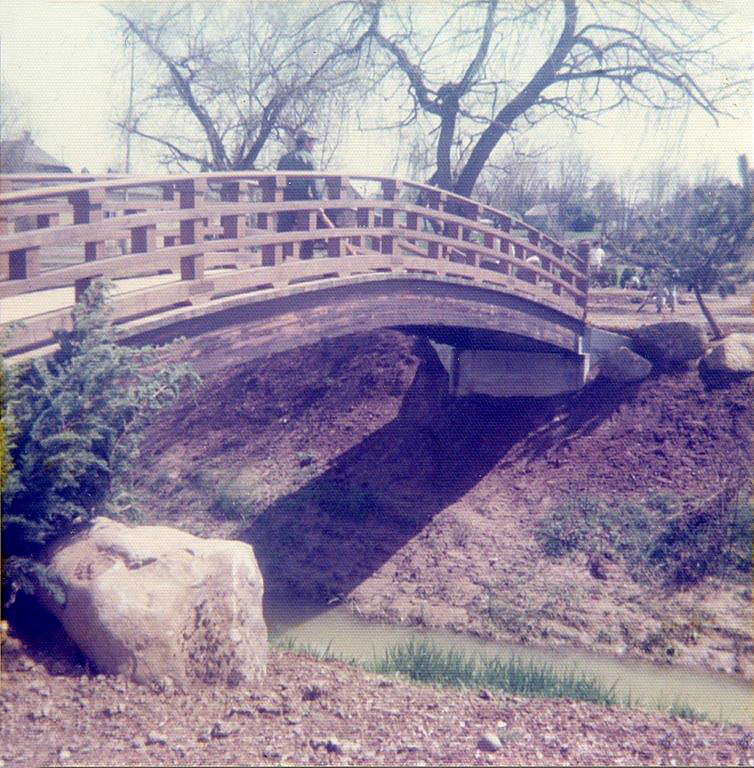
1970s
The island was free standing and as part of the project, a bridge had been built to connect the mainland and the island. The area was most likely just called “the island.” This piece of land was about an acre based on the pictures and maps that we have available today and had more land on the northwest and east sides than we see today. Along with these changes involving the creeks and the surrounding area, Main City Park had the lower baseball field and a large refreshment area similar to the area we have today.
We don’t have much history, but we do know that the bridge was engineered and components were built offsite and brought to the garden for assembly.
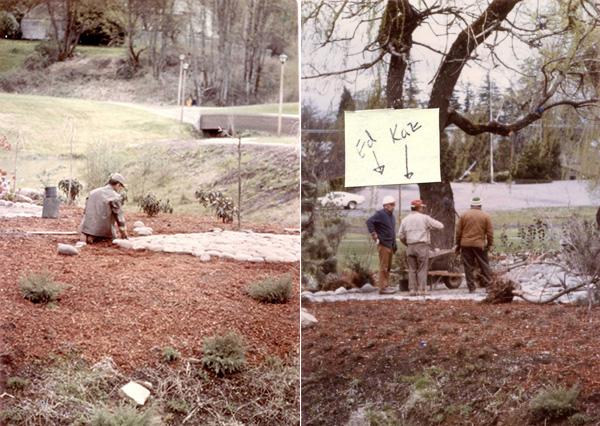

1974-1975
Ed Fugi and Kaz Tamura reviewing the placement of rock for placement as part of the path. The JACL developed a committee to work with the garden designer Sam Iwamoto, who may have been a member of the organization to find materials and figure out a way to get those materials to the work site. Much of the garden was built during the fall and winter months and it is assumed it was because many of the volunteers were farm people in the community, growing vegetables, fruits, flowers and other farm products; those months were part of the non-growing season that would allow them some time to volunteer for such a project.
The island was lined with 5000 river rock from the Clackamas River and boulders from the Columbia River. This is of the east end of the island and we see Johnson Creek and the walking bridge to the east of the island.
Work is taking place at the entrance of the bridge going to the garden. The boulder in the foreground is most likely staged for placement once some of the final excavation is complete. One can see the barn in the back ground.
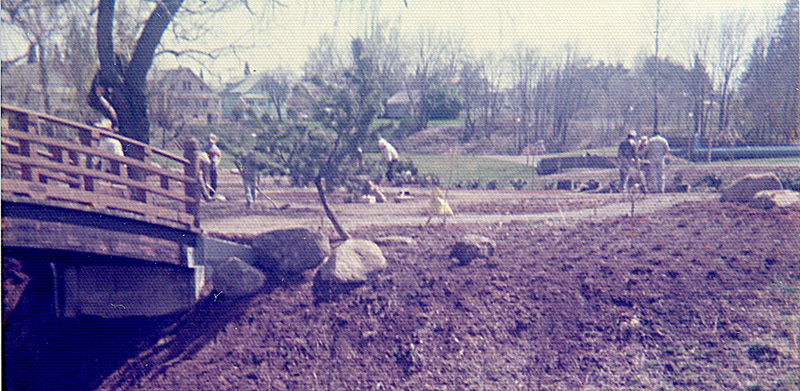
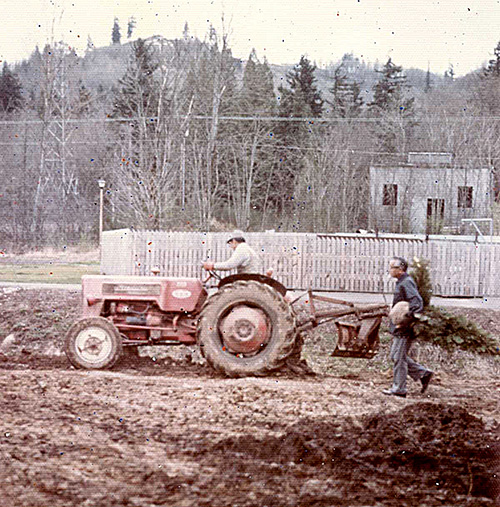
Preparing the Garden
Preparing the land for the garden. This photo is taken looking south with Gresham Butte in the background.
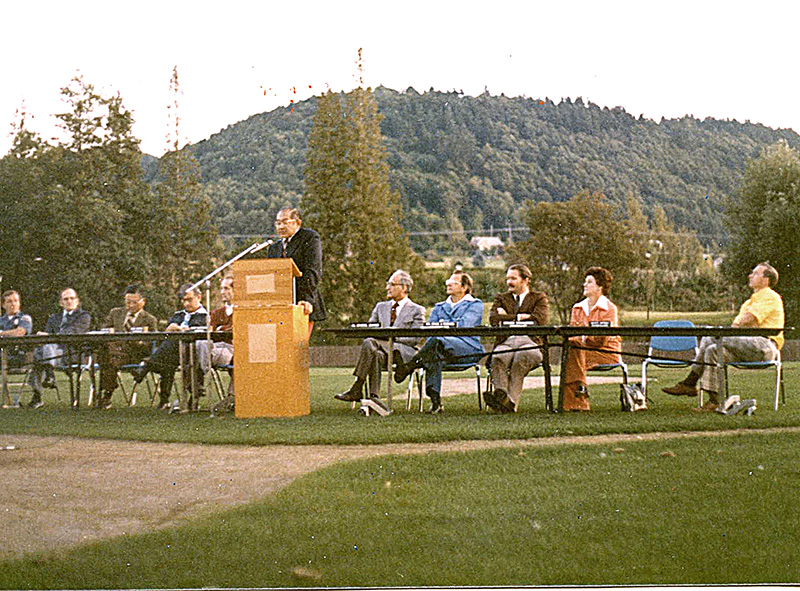

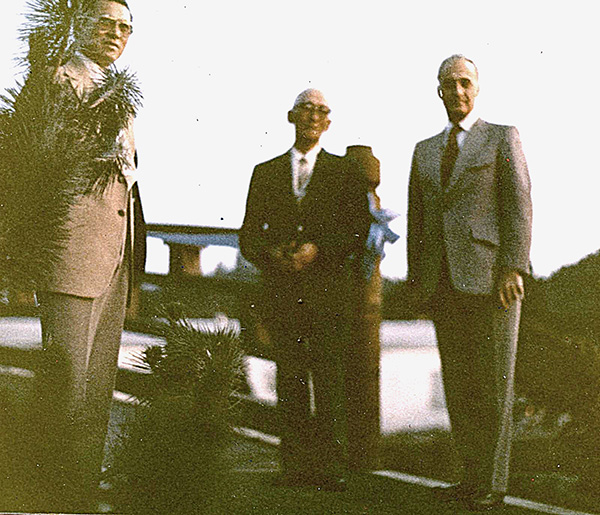
Dedication
September 2, 1975: Japanese Garden Dedication
Peace. Tranquility. Longevity. These were the themes of the Japanese Garden in Gresham Main Park on September 2, 1975. Picture shows the dedication on the baseball field with Sam Iwamoto, Landscaper; Co-chairmen of the garden committee Kaz Tamura and Yosh Mishima. The garden committee included Dr. Joe Onchi, Henry Kato, Shig Nagae, George Ninomiya, Shiro Takeuchi and Mits Nakamura.
Photo 1: Dedication at Main City Park. Speaking is Kaz Tamara, JACL president.
Photo 2: This picture was taken after the dedication ceremony of the garden, by the Japanese American Citizens League to the City Of Gresham, September 2, 1975. The location is at Main City Park at the refreshment stand behind the baseball field.
Photo 3: Sam Iwamoto, Newton Takashima, and Mayor of Gresham, Al Myers.
The Gresham Sister City Association was formed in 1977 between Gresham and Ebetsu, and that same year former Mayor Elmer Summerfield led a delegation to Japan, where the connection was made official. Later, a ceremonial cherry tree was planted in Main City Park.
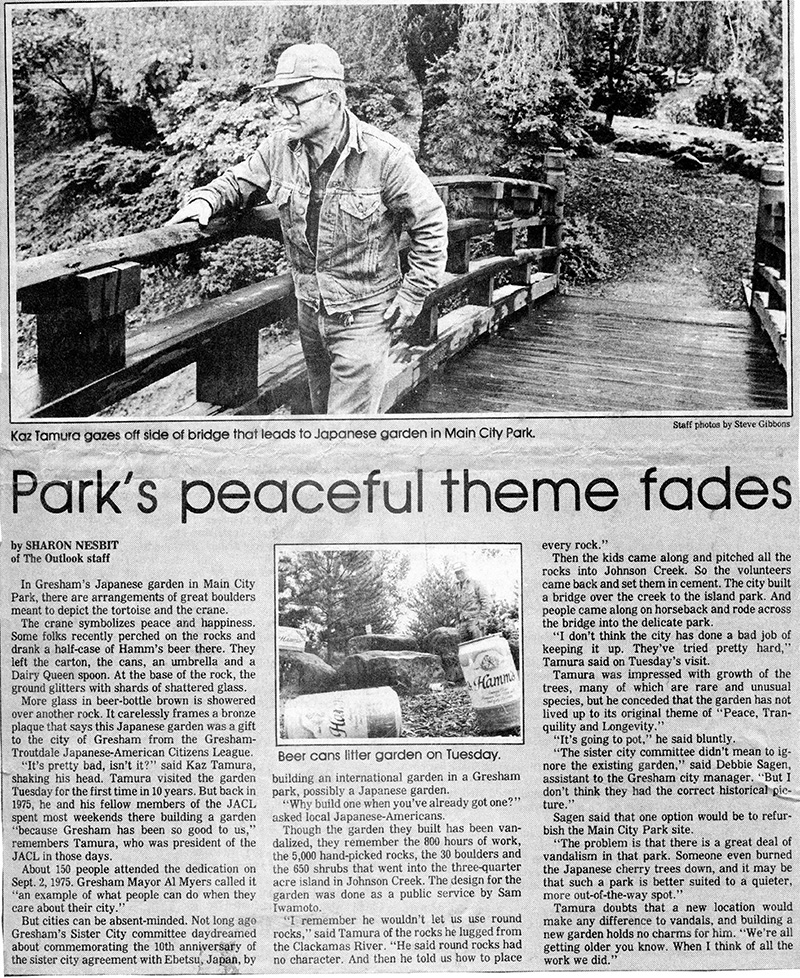
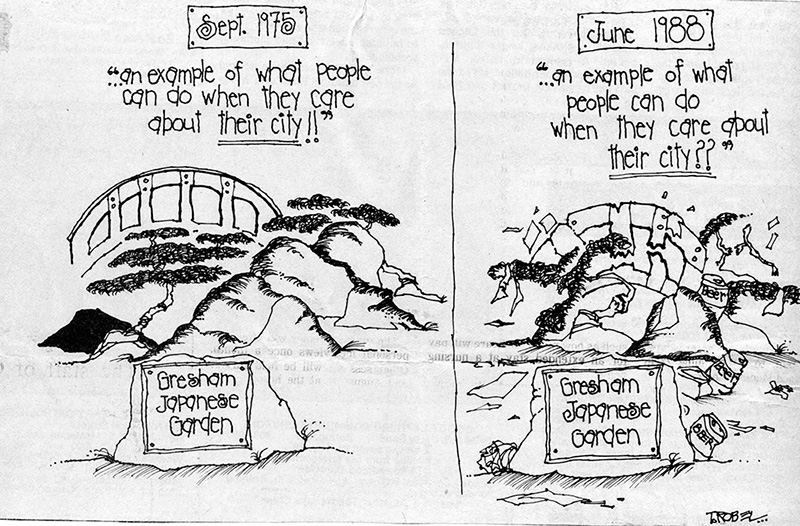
Early ’80 to 2011
Unfortunately like many Japanese gardens in the United States, Tsuru Island went into disarray. The Japanese American Citizens League of Troutdale/Gresham could not keep up with the maintenance of the garden.
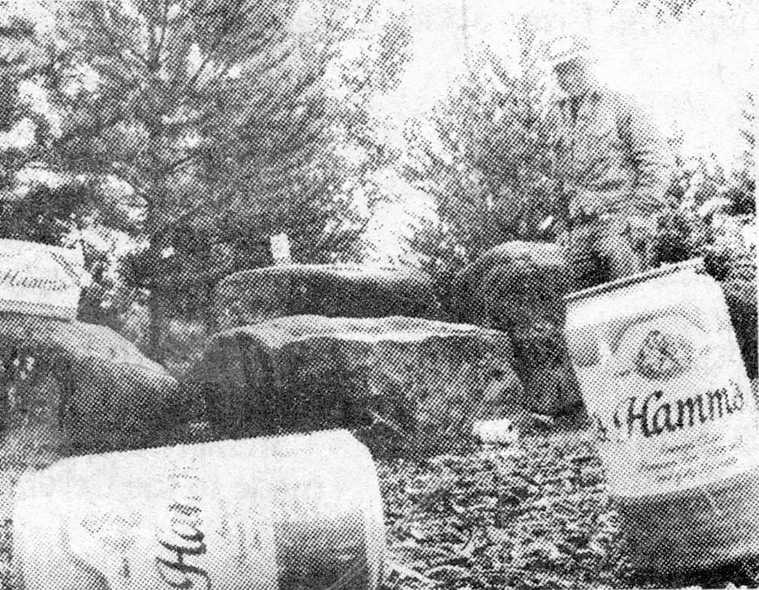
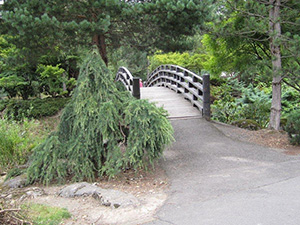
2011: Tsuru Island Discovery
In May of 2011 Tamiko Takeuchi invited her landscaper, Jim Card with Card Landscaping to Tsuru Island to “look”. The goal in 2011 was to “clean up” the garden by cutting trees, pruning, removing blackberries, etc. After extensive work and communication with the City it was apparent that Card and Takeuchi needed to find a non-profit to partner with. The JACL donated money to build the path, the City found volunteers and eventually the Gresham-Ebetsu Sister City Association adopted the Tsuru Island.
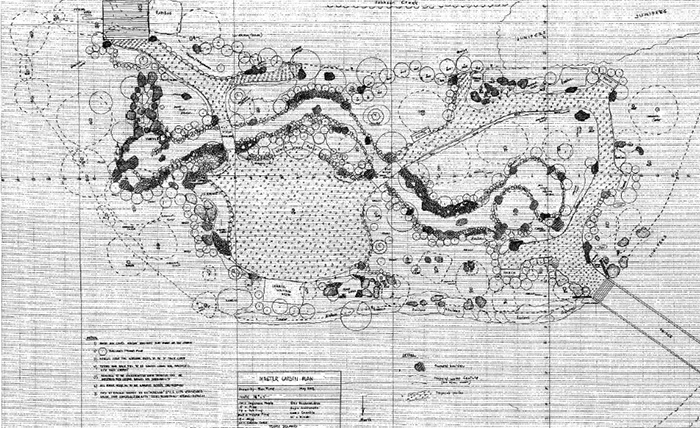
2012: Design Process
For Jim Card to develop the garden’s master plan, he observed erosion issues that had affected the island for years. A master plan started taking shape and was finished in six months. Although, re-designers of the original garden consulted with Sadafumi Uchiyama, curator of the Portland Japanese Garden, and Japanese master gardener Toru Tanaka of Portland Landscape Design and Japanese Garden Specialty, this was not going to be a traditional Japanese garden.
The second process was the construction of the garden. All the plants were measured, documented in their exact location and spacing, and the water problem was understood.

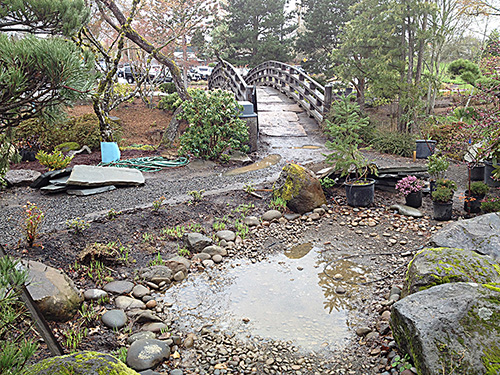
2013: Tsuru Island Construction
The construction of the revitalized Japanese Garden took all of 2013 under the direction of Jim Card and the approval from the City of Gresham. All throughout 2013 the irrigation, digging of trenches, electricity installed, boulders found and set in place, drainage system developed, basically everything except planting, lighting, and laying of the blue stone pathway happened in 2013. With constant communications with the City, volunteers from neighborhood groups started gaining traction and the the hard work was completed.

2014: Garden Rebirth
In the Spring of 2014 the Garden was ready to be unveiled. Over 8000 hours was dedicated in making this unforeseen challenge come to fruition. The Garden plantings are made up of those that existed from the original garden build and those that were installed as the result of the new design. Many varieties of junipers exist on the island and all of them were from the original planting.
Some of the original plants include pines, hinoki, bamboo, dogwood tree, azalea, camellia and andromeda. In some cases a grouping of plants were established and over the 40 years some have been removed for various reasons. No records were kept about the plantings in the original garden, however we do have pictures showing some of them being planted with where they can be seen and identified today.
This record allows us to determine what year the plants were installed and in most cases what month as well. An example is that we have a picture showing azaleas that currently exists flanking both sides of the bridge. These azaleas were planted in April, 1974. We can see that they are blooming and they still bloom in April of each year.

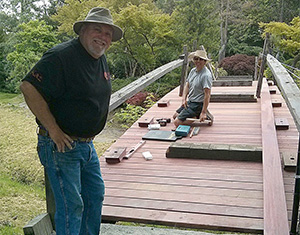
2015: Bridge Completed
For design inspiration, in 2013 Card visited the bridge at the Nishinomiya Tsutakawa Japanese Garden in Spokane, Washington. The new Tsuru Island bridge is wider and twice as long. Jim Card purchased purple heart wood with 75% of the materials funded by the City of Gresham, the planning and construction of the bridge was to begin.
Jim Card and numerous volunteers sawed, machined, and glued all the pieces to construct the bridge—in Jim’s home workshop, and they were also allowed to use the industrial shop belonging to Quality Woodworking. This endeavor took roughly six months to complete. Once again, volunteers made this happen under the meticulous direction of Jim Card. By June of 2015, the old bridge was demolished. In July of 2015 the new bridge was completed with the finishing touches of a finial to each post called a Giboshi— a standard for bridges in Japan.
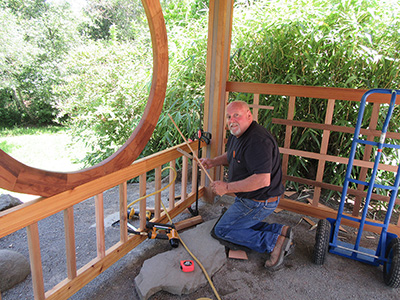
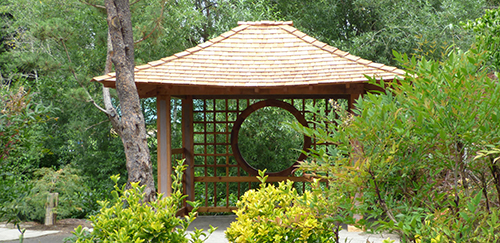
2016: Azumaya
Early in the design process for the Garden, we determined that there would be a central area for small meetings, entertainment, displays and just relaxing. Kent Thompson set up a team of volunteers just like they did for the bridge project. All of the cutting was done at Jim’s wood shop. Many sections were prefit for accuracy and lots of discussions about the fitting process and future movement of materials. All precut components were coated with the Rosewood oil before leaving the shop.
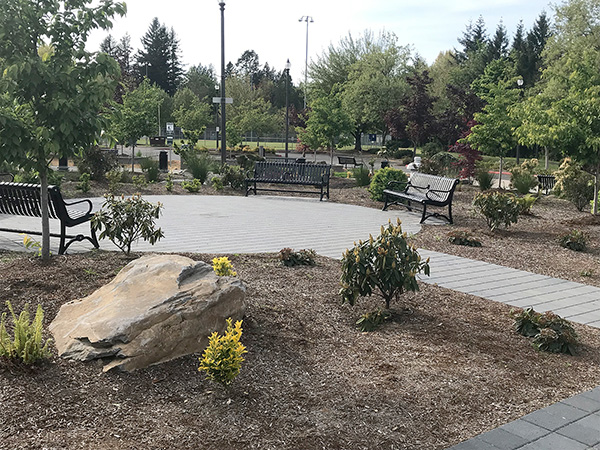
2017: Ebetsu Plaza
Following the rebirth of Tsuru Island, Jim Card and dedicated volunteers had their eyes set on revitalizing the south end of Main City Park, starting with the transformation of a parking lot into what is now called Ebetsu Plaza.
On Saturday morning, Sept. 8, 2017, the community gathered for the grand opening of Ebetsu Plaza, named in honor of the 40th anniversary of Gresham’s sister-city pact with Ebetsu, Japan. The event featured refreshments, goody bags and koto music .
“We were originally going to name it Tsuru Plaza, but we realized it would be perfect to name it Ebetsu Plaza,” Card said.
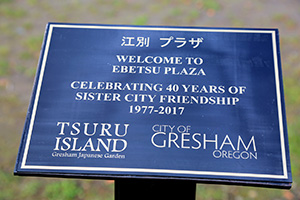
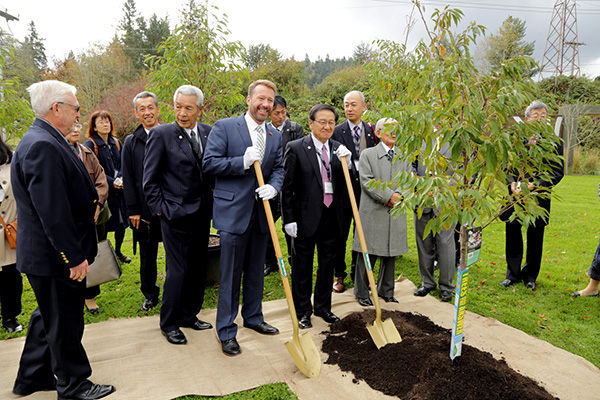
10 Trees in 10 Parks for 10 Years with Delegates from Ebetsu, Japan
The city of Gresham in its 10th years as a Tree City USA. celebrated Arbor Month April 5, 2018 with planting 10 Akebono cherry trees in the newly broken ground of Ebestu Plaza. The trees were graciously donated by our friends at J. Frank Schmidt Nursery.
“A tree is very emblematic of our relationship — we have deep roots but continue to grow,” Mayor Bemis said.
Those behind Ebetsu Plaza have another way to bring the community together, and raise needed funds for it and the Japanese Garden.
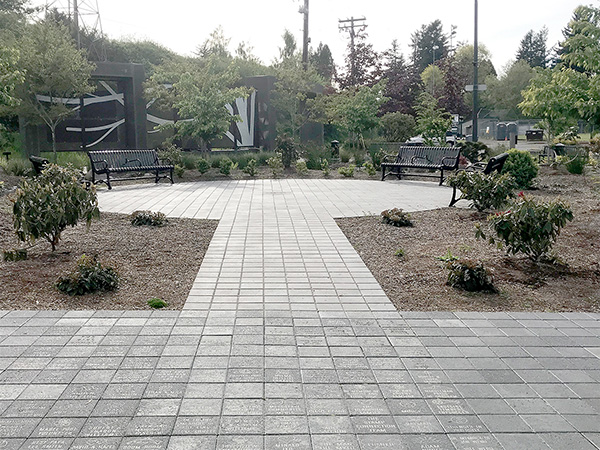
Touchstone Paver Campaign
The purpose of the Touchstone paver campaign is to create financial security for the Gresham-Ebetsu Sister Association, who was the umbrella non-profit organization. Card did not want the mistakes of the past to happen again. He set up an endowment fund with Edward Jones where all the proceeds from the paver campaign are deposited.
The Touchstone Paver fundraiser’s design is to engrave16 large business pavers and approximately 3000 tiles on the pathway of Ebetsu Plaza. Community members can have a message engraved. The campaign enlisted approximately 12 non-profits to receive 20% of the proceeds when the paver purchaser designated their non-profit of choice. A few of these non-profits were: SnowCap Charities, Gresham-Barlow Education Foundation, Eastside United FC, Apple of His Eye Charity, Gresham Youth Baseball, Mt. Hood Hospice, Meals on Wheels, and Salvation Army. By 2022, this portion of the campaign was eliminated, but the paver campaign is still going strong.
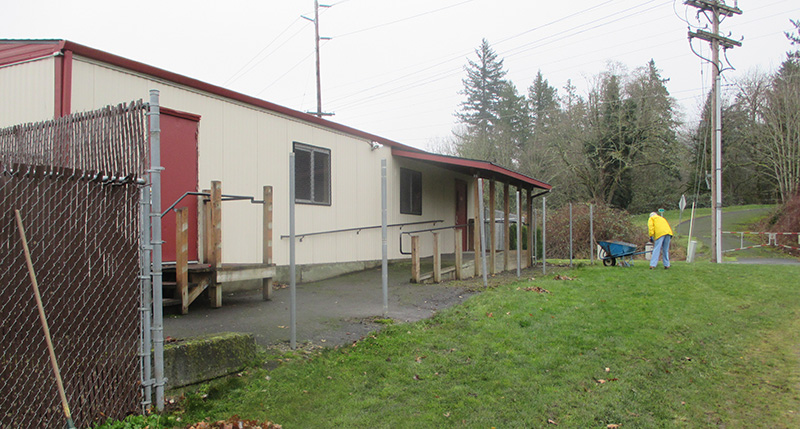
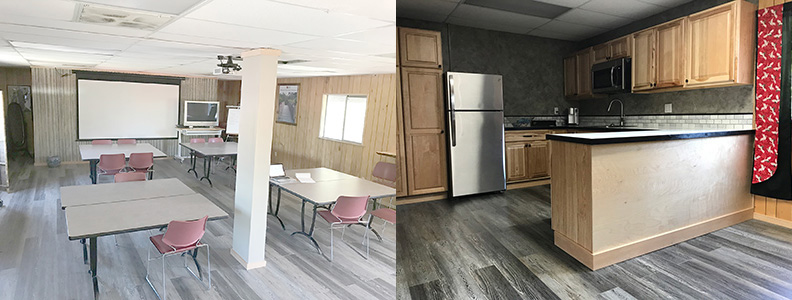
2018-2022 Resource Center
In 2018, Jim Card asked the City of Gresham if GESCA could use the building that was slated to be demolished. This building was renamed the Resource Center and became the home for the volunteers of GESCA.
The remodeling began immediately with the replacement of the carpet. In 2019, Card and volunteers added a kitchenette. In 2021, a restroom was added.
In the winter of 2022, the major remodel began with the removal of the drop ceiling and rerouting of the HVAC system. In early 2023 the sukiya living transformation began with the installation of the 12′ sliders, 6′ moon window, and then subsequently a wrap-around patio, siding, and roof tiles and onigawaras.
The major transformation was completed by September of 2023 in time to host a North America Japanese Garden Association 4-day regional conference.

2020: GJG Becomes its own 501 (c)3
From 2014-2019, Tsuru Island’s rebirth came under the umbrella of the Gresham-Ebetsu Sister City Association. In 2020, Jim Card, Garden Director chose to create a 3-person board, non-profit organization, naming it the Gresham Japanese Garden.
The three board members were Jim Card, director, Sue Protz, secretary, and Katey Card, treasurer.
In 2022, Mary Taylor became treasurer and Sue Protz was named Activities Director.
Greenhouse: Exploratory Worksite Program
In June 2019, GJG submitted a grant for $7,500 to establish a training worksite for adult learners with special needs to gain job skills in the horticulture industry. With the Community Enhancement grant money from the city of Gresham, GESCA constructed a greenhouse.
Then in Fall of 2019, we launched the Exploratory Worksite Program offering our service to the Gresham-Barlow School District Adult Living Program. GJG’s worksite program is the only worksite that provides two teachers, and twice a week. We specifically teach a full-spectrum of horticulture skills, from seed germination to transplanting, weed control, plant care, and more.
Fulfilling an Exploratory Worksite Program goal, GJG landed an internship for our adult learners with Al’s Garden & Home Gresham. In Spring of 2024, GJG sen the six students who were from the first series of students to go through the program from first year to third year, gained work skills in a real-life job setting.
In 2024/25, GJG added Cornerstone adult learners from Reynolds School District.

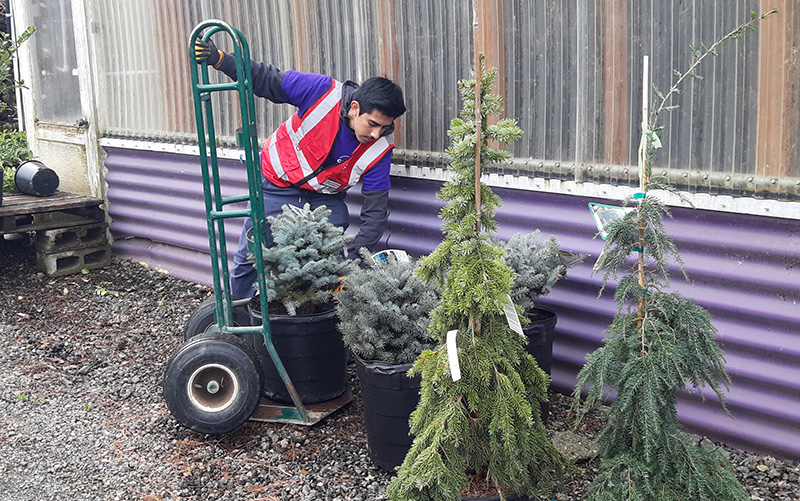

2022: Mural Garden
In 2021-22, the Gresham Japanese Garden won a Community Enhancement grant for a mural on the facade of the barn. The distance from Tsuru Island and the south end of the Garden’s spaces felt disconnected. The intent of the mural was to make a smoother transition between the two.
The original design was for the mural to be painted directly onto the barns T 1-11 siding, but after consultation from COG facilities department, it was determined that the facade was not in good enough condition. Consequently, we painted the mural on individual sheets of plywood and mounted it on its own frame not being attached to the barn. Thus creating a three-dimensional mural. The theme was Gresham’s Japanese American agriculture history. The mural was painted by a Portland mural artist, Madison Hughes and completed in July 2022.
2022: Hiroshima Peace Garden
Since Juy 2011, Green Legacy Hiroshima (GLH) has been sending seeds and seedlings to organizations to be planted in parks, schools, and gardens of public facilities. The City of Gresham was gifted a Ginkgo biloba sapling and designated a space in Main City Park for its final placement.
The tree’s new home, called the Peace Garden, across from Ambleside Annex at the south end of Main City Park, was officially dedicated on September 19, 2022. David Hedburg, a filmmaker who captured the transfer of the tree to Jim Buck from Jim Gersbach of the Oregon Department of Forestry and has documented many of the Peace Tree installations around Oregon, will film the ceremony.
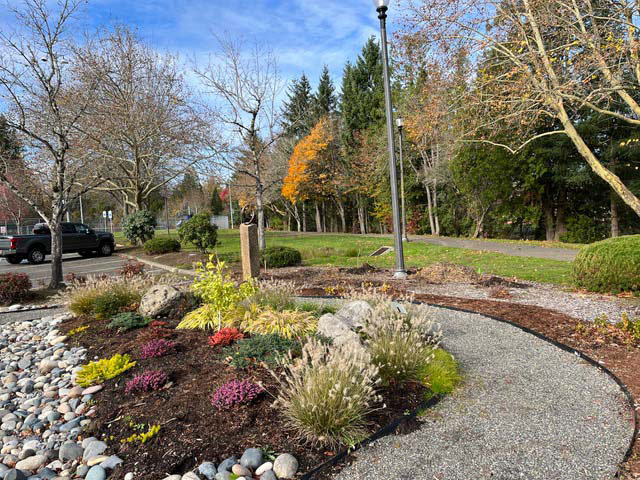
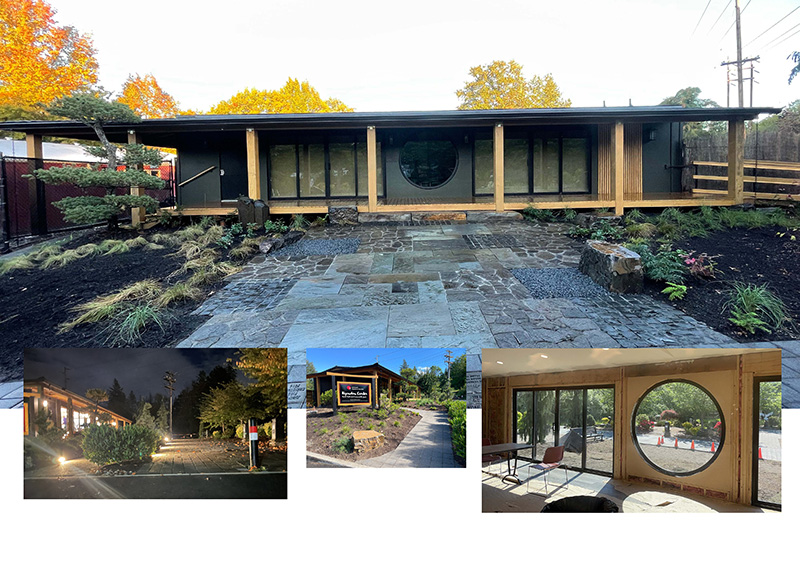
2023-2024 Kyoudou Center
The Resource Center received a huge remodel starting in the winter of 2022 and finished in the Fall of 2024. The remodel also gave the Garden the opportunity to update its image. Kyoudou means community, collaboration. Dr. Kendall Brown helped us come up with the name, as he did the word “rebirth” for the transformation of Tsuru Island.
We started with the removal of the drop ceiling, an HVAC overhaul, and all the walls drywalled and painted—all by volunteers. The Spring of 2023 started the hard work of the exterior and transformation of the building to sukiya living. The facade consists of a 6′ moon window and two 12′ sliders donated by Milgard Windows. The patio was built by volunteers while the 8′ overhang and roof was outsourced. The hardy board siding was also installed by volunteers.
In the Spring of 2024, the backside of the Kyoudou Center received a 4′ overhang and siding completing the remodel of the building and all performed by Garden volunteers.
The onigawaras were designed by Blane Bellerud. Traditionally, onigawaras are placed on roofs to protect the building from devils and demons. There are many styles, but Jim thought that having a tsuru (crane) would be appropriate for the Kyoudou Center. Read article on the onigawara tiles.
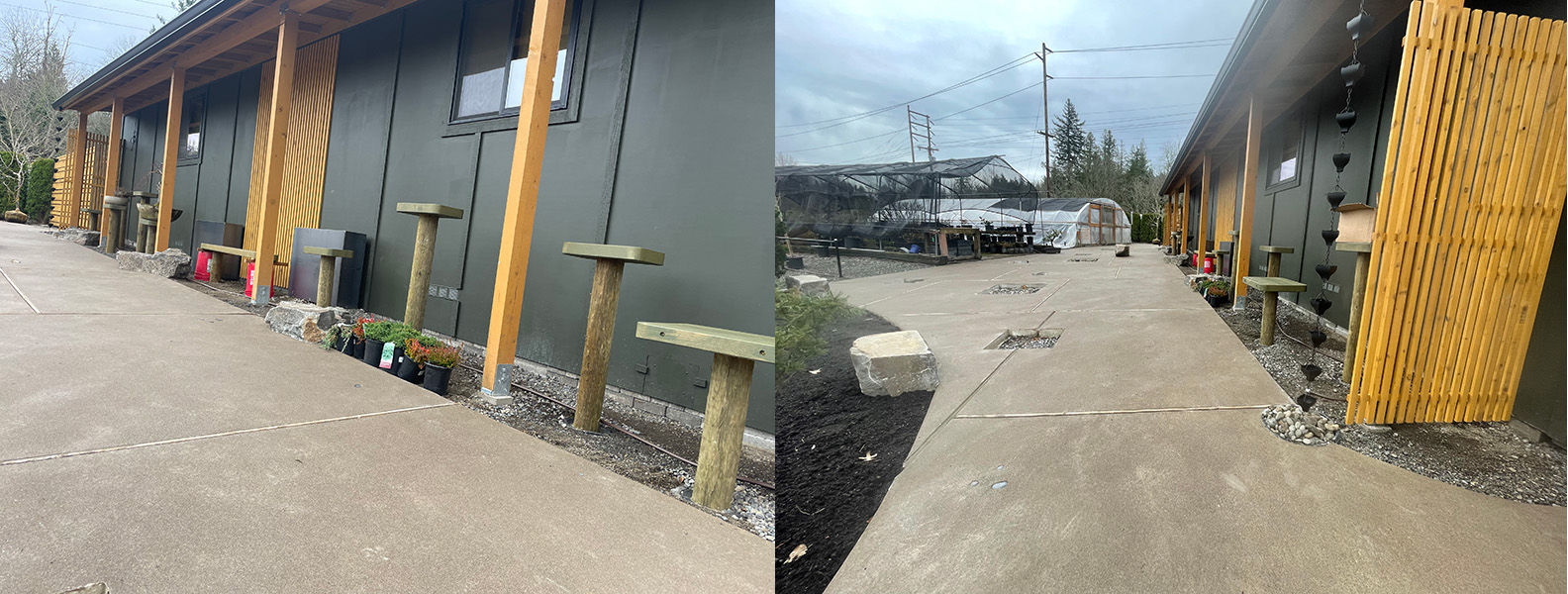
2024: Exhibition Plaza
The impetus for the Exhibition Plaza started with a generous donation from Sue Ellen White in rememberance of her brother, Hal White.
The exhibition plaza is located behind the Kyoudou Center and will be a beautiful, secure location for bonsai, chrysanthemum, and more displays.
